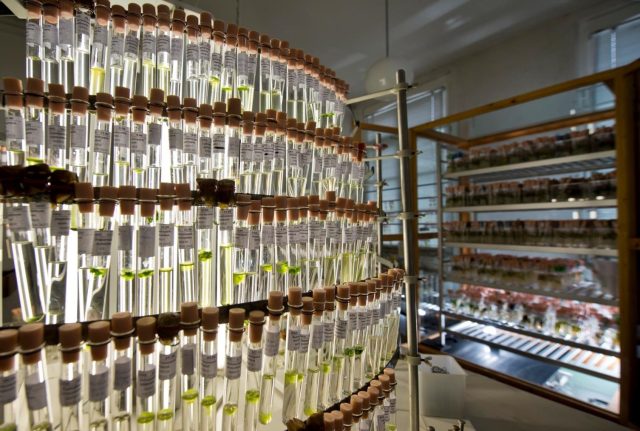- Collection name: Sammlung von Algenkulturen at University of Goettingen
- Acronym: SAG
- WDCM number: 192
- Institution: Georg-August-University Goettingen, Dept. Experimental Phycology and SAG Culture Collection of Algae
- Address:
Nikolausberger Weg 18
D- 37073 Goettingen
Germany - Website: http://www.epsag.uni-goettingen.de
Website of the catalogue or database of the collection: https://sagdb.uni-goettingen.de - Correspondence data:
E-mail: epsag@uni-goettingen.de
Tel.: +49 (0) 551 39 27870
Correspondent: Prof. Thomas Friedl (Director) +49 (0) 551 39 27868 & Dr. Maike Lorenz (Curator), +49 (0) 551 39 25740
Members holdings
Groups of biological resources stored in the collection: cyanobacteria (218 strains in public catalogue), other fungus- like organisms (1 strain in public catalogue), eukaryotic algae (over 2100 strains in public catalogue), protozoa (1 strain in public catalogue), mosses (13 strains), higher plants (1 strain)
The SAG Culture Collection of Algae is a center of biological ressources and expert knowledge for algae and cyanobacteria serving research, teaching and biotechnology communities worldwide.
SAG primarily comprises microscopic algae and cyanobacteria from freshwater and (aero-)terrestrial habitats, but also marine algae are kept in serial transfer and/ or cryopreserved in ultralow temperatures. With over 2350 strains (representing 538 genera and 1424 species) in its public collection the SAG is among the largest culture collections of algae and cyanobacteria in the world. Professionally curated metadata on origin, publications, morphology, genetic fingerprints and omics data add to the value of SAGs ressources. The collection covers an extremely broad taxonomic range with algae and cyanobacteria originating from an equally diverse variety of geographical and ecological niches. Over 20% of SAG´s strains are authentic or type strains. SAG is involved in various research projects as well as education and public relation.The SAG is a non-profit institution at Georg-August-University Göttingen, which covers all staff costs and provides culture rooms and laboratories. Running costs are solely funded by the dispatch of culture strains and other services.
Services offered
SAG provides cultures of algae and cyanobacteria primarily for research, teaching and screening purpose. Actively growing cultures are available for all interested individuals and organizations in the framework of a material transfer agreement. Customers are scientists worldwide from various types of institutions, industry, environmental research agencies etc.. Public and confidential strain deposits are offered. SAG is involved in academic training on isolation, identification, cultivation and preservation of algae and cyanobacteria and curation of collections holdings. Other services (consultation, identification, culture media etc.) are available on request. SAGs online catalogue serves as a knowledgebase incl. a variety of metadata (incl. molecular, morphological and cultivation information).
Research
SAG strains and expert knowledge constitute a research resource intensively used in the international arena. The number of molecular fingerprints and genomes is constantly being expanded through our own and external research activities. The research of the department Experimental Phycology and SAG (EPSAG) focus on the phylogeny and diversity of microscopic algae and cyanobacteria. Third party funded research projects look e.g. at the diversity of terrestrial algae and cyanobacteria, the diversity of freshwater red algae (Rhodophyta) or the symbiotic competence of cyanobacteria.
Surplus SAG collaborates on diverse research projects e.g. on land plant terrestrialization, biophysics of motile algae and automated phytoplankton-identification using AI.
10 selected publications closely related to SAG Culture Collection Research:

